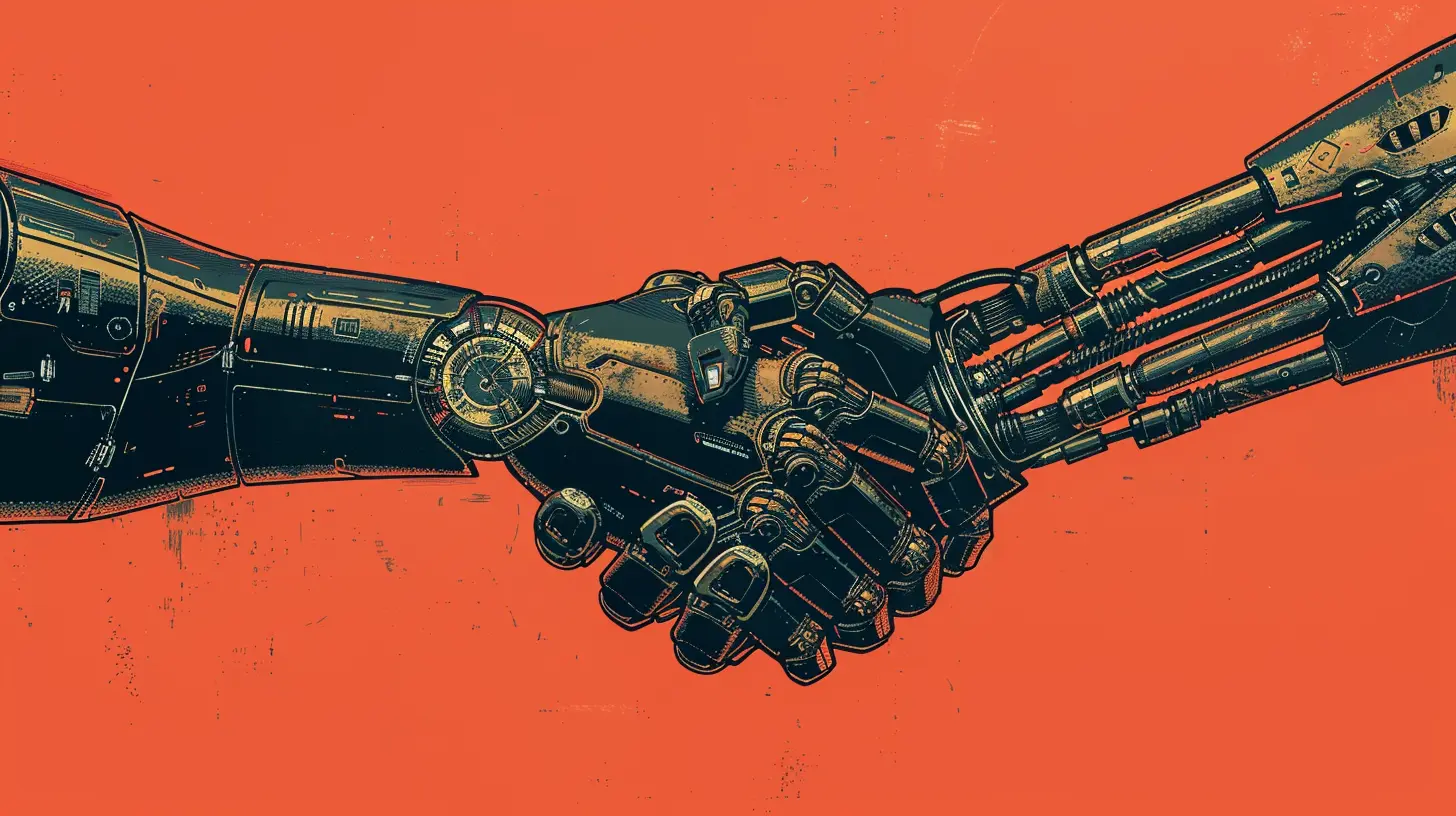AI and the Problem of Consent in Data Collection
4 November 2025
Welcome to the wild west of tech ethics, where artificial intelligence is racing ahead like a runaway train, and everyone’s still arguing about whether we remembered to install the brakes. One of the biggest and messiest challenges? Consent in data collection.
That’s right. In a world where your data is the new oil, the idea of giving "consent" before your digital DNA gets hoovered up by AI algorithms is murky at best—and flat-out broken at worst.
Let's unpack the chaos, shall we?
What’s the Big Deal With AI and Consent Anyway?
On paper, the idea is simple: you should have control over who gets your data, what they do with it, and when they can use it. That’s consent. It’s the 21st-century version of giving someone the keys to your house—they can't just walk in unless you say it's cool.But AI doesn’t really knock. It mines. It scrapes. It watches. And most of the time, it doesn’t even bother to ask.
AI models need training data—lots of it. Mountains of personal photos, videos, voice samples, text, clicks, locations, and pretty much everything else that makes up your digital life. The problem is, no one really asked you if it was okay to use that stuff.
So here we are—caught in a perfect storm of powerful algorithms, murky regulations, and a vague checkbox at the bottom of a privacy policy no one really reads.
How Did We Get Here? (Spoiler: It Wasn't All That Transparent)
Let’s rewind a bit. For decades, tech companies have collected user data under the banner of "improving your experience." That’s how we got personalized ads, smarter search results, and eerily accurate Netflix recommendations.But that same logic morphed into machine learning models that can predict your mood, target your political beliefs, or generate deepfakes that even your mom couldn't tell were fake.
Where did all that training data come from?
- Social media posts? ✅
- Public forums? ✅
- Surveillance footage? ✅
- Online medical advice boards? ✅
And did every person whose data was used agree to it?
Nope.
Most AI systems today are trained on data harvested without explicit consent. Public doesn’t always mean permissible. Just because something is out there doesn’t mean you gave permission to feed it into an AI black box.
The Consent Illusion: Are We Really Saying “Yes”?
You know those cookie pop-ups that say “By continuing to use this site, you agree…”?That’s not real consent. That’s coercion dressed up like UX design.
True consent requires three things:
1. Clarity – You know what you’re saying yes to.
2. Freedom – You’re not forced or tricked into agreeing.
3. Control – You can opt-out whenever you want.
Now tell me—when was the last time you felt you had any of that when dealing with a new app or online platform? Exactly.
Too often, we’re bombarded with legal jargon so dense it might as well be written in Klingon. And if you don’t agree? You don’t get access. That's not a choice—that’s a digital hostage situation.
AI Creeps Behind the Scenes
Here’s the kicker: a lot of the time, your data is used in ways you can't even see.Let’s say you uploaded a photo to a publicly visible Instagram account. That photo gets scraped by a third-party group building a facial recognition algorithm. Their AI is trained using YOUR face to identify strangers around the world.
Did you get an email about it? Were you offered the chance to opt out?
Hell no.
The same goes for voice data, browsing history, search queries, online reviews—even your handwriting. AI feeds on every crumb of your online existence. And once it’s gobbled up, it becomes part of a massive, often untraceable data set.
The Legal Grey Zone—Okay or Just Not Illegal?
This is where things get slippery. Regulations like the EU’s GDPR or California’s CCPA are trying to rein in this madness. They emphasize transparency, user rights, and data protection.But here’s the rub—they were written for human-scale data handling. Not AI-scale.
AI doesn’t just collect data. It processes, transforms, and generates new data sets—synthetic profiles, predictive models, behavioral predictions. Even if you delete your account, your ghost data lingers, lurking in the training set of some startup’s model.
Plus, many companies operate in jurisdictions where regulations are unclear or flat-out nonexistent. So if you're relying on laws to protect your privacy from AI, you might be bringing a butter knife to a gunfight.
“Public Data” Doesn’t Mean “Fair Game”
Let’s kill this myth right now: just because something is public doesn’t mean it’s ethical (or even legal) to use it for AI.Imagine you stood in the town square and read a diary entry out loud. That doesn’t mean someone can record it, remix it into an AI chatbot of your personality, and then sell it to a marketing firm.
Context matters.
Your data might be public in context, but AI rips it out of that context and transforms it into something you never agreed to. That’s not sharing—that's exploitation.
The Deepfake Dilemma & Synthetic Consent
Let’s talk about deepfakes for a minute. AI tools can now clone your voice, mimic your face, and animate your movements with uncanny realism. All they need is a few publicly available clips. Maybe even just a podcast, a YouTube video, or a LinkedIn profile picture.And boom—you’ve been cloned.
It’s one thing for a friend to share your funny TikTok. It’s another for a company to use your likeness to advertise a product or impersonate you in another video.
Where’s the consent in that? Spoiler: There isn’t any.
So... Is There Any Way to Fix This?
Short answer: It’s complicated. But we’re not totally doomed—yet.Here’s what needs to change (spoiler: it’s a lot):
1. Redefine Consent for the AI Age
Consent needs to be dynamic, ongoing, and meaningful. We need tools that let you actually understand how your data is used, and systems that check back in with you over time—not just once when you sign up.2. Transparent AI Models
Can’t see what’s inside the AI? That’s a problem. Black-box models don't just obscure how decisions are made—they also hide where the data came from. We need transparency like we need Wi-Fi—everywhere, always on, and open to inspection.3. Informed Opt-In by Default
Make data collection opt-in, not opt-out. The burden shouldn’t be on users to read 12 pages of Terms & Conditions written by a caffeine-fueled lawyer at 3 am. Give us clear, simple choices. Like a menu—not a contract.4. Meaningful Regulation With Teeth
Governments need to get serious. That means harsh penalties, real enforcement, and international cooperation. Because AI data scraping doesn’t stop at borders—why should our privacy laws?5. Tech Companies Owning Up
It’s time for tech giants to stop hiding behind "innovation" as a catch-all excuse. Just because you can build it doesn’t mean you should—especially if you’re building it on a mountain of non-consensual data.Can Consent Ever Catch Up to AI?
Here’s a scary thought: What if the concept of consent itself is broken when it comes to AI?Consent in the digital age needs to be fluid, flexible, and powerful enough to deal with systems that constantly learn, adapt, and change how they use data. That’s a moving target.
Maybe we need to go beyond consent. Maybe it’s time to talk about data sovereignty—the idea that you own your data like you own physical property. It’s yours. You get to lease it, license it, sell it, or lock it away forever.
Until we move toward that kind of radical ownership, AI will keep feeding on anything it can get—and we'll keep scrambling to catch up.
Final Thoughts: We Need a Consent Revolution
Let’s be blunt—this tech isn’t going away. AI is already deeply embedded in our lives. From Siri answering your questions to behind-the-scenes recommendation systems deciding what you see online, it’s here to stay.But if we don’t figure out how to meaningfully fix the consent problem, we risk building a digital future where privacy is nothing more than a nostalgic concept. Like VHS tapes or dial-up.
We need radical transparency. We need digital rights with real bite. And we need to reclaim control over our own data—not just for ourselves, but for future generations who will grow up with this tech embedded in every part of their lives.
So the next time you post a photo, use an app, or sign up for a new tool—ask yourself: Did I really consent to this?
Because if we don’t ask those questions now, AI will never stop answering them for us.
all images in this post were generated using AI tools
Category:
Ai EthicsAuthor:

Marcus Gray

